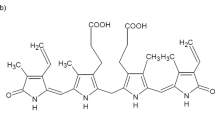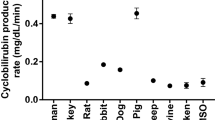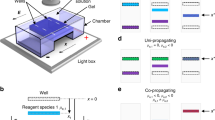Abstract
IN the absence of proteins, unconjugated (indirect) bilirubin is known to be immobile in an electric field. However, in a buffer system containing ethylenediamine tetraacetic acid (EDTA), for example, the EDTA-tris-boric acid buffer described by Aronsson and Grönwall1 or in a buffer solution containing only 0.021 mol. EDTA (ref. 1) adjusted above pH 7.0 by adding sodium hydroxide, I found bilirubin (alkaline solution) to move towards the anode when submitted to paper electrophoresis. Moreover, applying an EDTA containing alkaline solution of bilirubin in any alkaline buffer system, for example, Michaelis barbital buffer to electrophoresis, the same phenomenon occurs (Fig. 1). After terminating electrophoresis in EDTA the displaced spots of bilirubin were found yellow and yielding the diazo reaction by Verschure's method2 even more readily than bilirubin without EDTA; however, in contrast to the latter the spots of bilirubin in EDTA turned to green in the lapse of some days. The motility of bilirubin in EDTA was found undisturbed by the presence of excess amounts of Ca++, or by pretreating bilirubin with ditizon dissolved in carbon tetrachloride, to remove metal traces if present. (This pretreated bilirubin failed to move in an alkaline buffer not containing EDTA)
This is a preview of subscription content, access via your institution
Access options
Subscribe to this journal
Receive 51 print issues and online access
$199.00 per year
only $3.90 per issue
Buy this article
- Purchase on Springer Link
- Instant access to full article PDF
Prices may be subject to local taxes which are calculated during checkout
Similar content being viewed by others
References
Aronsson, T., and Grönwall, A., Scand. J. Clin. Lab. Invest., 9, 338 (1957).
Verschure, J. C. M., Clin. Chim. Acta, 1, 38 (1956).
With, T. K., Biologie der Gallenfarbstoffe, 153 (Thieme Verlag, Stuttgart, 1960).
Odell, G. B., J. Clin. Invest., 38, 823 (1959).
Jendrassik, L., and Gróf, P., Biochem. Z., 297, 81 (1938).
Childs, B., Bull. Johns Hopkins Hosp., 97, 333 (1955).
Author information
Authors and Affiliations
Rights and permissions
About this article
Cite this article
KAHÁN, I. Electrophoretic and Spectroscopic Observations of Bilirubin in the Presence of Ethylenediamine Tetraacetic Acid. Nature 202, 1216–1217 (1964). https://doi.org/10.1038/2021216a0
Issue Date:
DOI: https://doi.org/10.1038/2021216a0
Comments
By submitting a comment you agree to abide by our Terms and Community Guidelines. If you find something abusive or that does not comply with our terms or guidelines please flag it as inappropriate.



